
The Śvētāmbara is one of the two main branches of Jainism, the other being the Digambara. Śvētāmbara means "white-clad", and refers to its ascetics' practice of wearing white clothes, which sets it apart from the Digambara "sky-clad" Jains, whose ascetic practitioners go nude. Śvētāmbaras do not believe that ascetics must practice nudity.

Parshvanath, also Pārśvanātha, Parshva, Pārśva and Parasnath, was the 23rd of 24 Tirthankaras of Jainism. He gained the title of Kalīkālkalpataru.
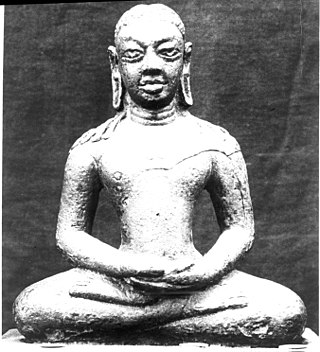
This was the first known bronze hoard discovered in the Gangetic valley and consists of a set of 18 Jain bronzes. The Chausa hoard, thus named after the place of discovery: Chausa or Chausagarh is located in the Buxar district of Bihar state, India.

Śāntinātha or Śānti is the sixteenth Tīrthaṅkara of Jainism in the present age. According to traditional accounts, he was born to King Vishvasena and Queen Aćira of the Ikshvaku dynasty in the north Indian city of Hastinapur. His birth date is the thirteenth day of the Jyest Krishna month of the Indian calendar. He was also a Chakravartin and a Kamadeva. He ascended to the throne when he was 25 years old. After over 25,000 years on the throne, he became a Jain monk and started his penance.

Mallinatha was the 19th tīrthaṅkara "ford-maker" of the present avasarpiṇī age in Jainism.
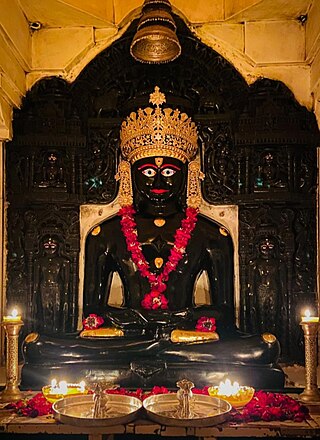
Neminātha, also known as Nemi and Ariṣṭanemi, is the twenty-second Tīrthaṅkara of Jainism in the present age. Neminatha lived 81,000 years before the 23rd Tirthankara Parshvanatha. According to traditional accounts, he was born to King Samudravijaya and Queen Shivadevi of the Yadu dynasty in the north Indian city of Sauripura. His birth date was the fifth day of Shravana Shukla of the Jain calendar. Krishna, who was the 9th and last Jain Vasudev, was his first cousin.

In Jainism, Ambika or Ambika Devi is the yakshini "dedicated attendant deity" or Śāsana Devī "protector goddess" of the 22nd Tirthankara, Neminatha. She is also known as Ambai, Amba, Kushmandini and Amra Kushmandini. She is often shown with one or more children and often under a tree. She is frequently represented as a pair with a small Tirthankar image on the top. The name ambika literally means mother, hence she is Mother Goddess. The name is also a common epithet of Hindu Goddess Parvati.

Jain sculptures or Jain idols are the images depicting Tirthankaras. These images are worshiped by the followers of Jainism. The sculpture can depict any of the twenty-four tirthankaras with images depicting Parshvanatha, Rishabhanatha, or Mahāvīra being more popular. Jain sculptures are an example of Jain art. There is a long history of construction of Jain sculptures. Early examples include Lohanipur Torsos which has been regarded to be from the Maurya period, and images from the Kushan period from Mathura.

Jainism is an Indian religion which is traditionally believed to be propagated by twenty-four spiritual teachers known as tirthankara. Broadly, Jainism is divided into two major schools of thought, Digambara and Svetambara. These are further divided into different sub-sects and traditions. While there are differences in practices, the core philosophy and main principles of each sect is the same.

Jain art refers to religious works of art associated with Jainism. Even though Jainism has spread only in some parts of India, it has made a significant contribution to Indian art and architecture.

The Akota Bronzes represent a rare and important set of 68 Jain images, dating to between the 6th and 12th centuries AD, which were found in the vicinity of Akota near Baroda in the Indian state of Gujarat. It includes rare Gupta period bronzes that have been widely used for comparison of Gupta period art.
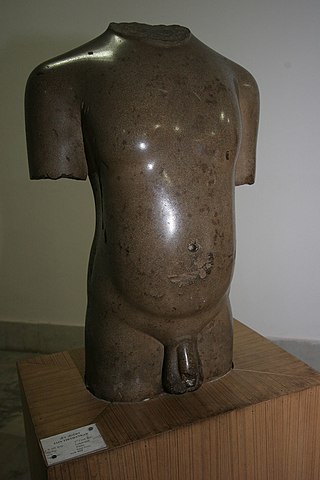
The Lohanipur torso is a damaged statue of polished sandstone, dated to the 3rd century BCE ~ 2nd century CE, found in Lohanipur village, a central Division of Patna, ancient Pataliputra, Bihar, India. There are some claims however for a later date, as well as of Graeco-Roman influence in the sculpting.The Lohanipur torso is thought to represent a Jaina Tirthankara.
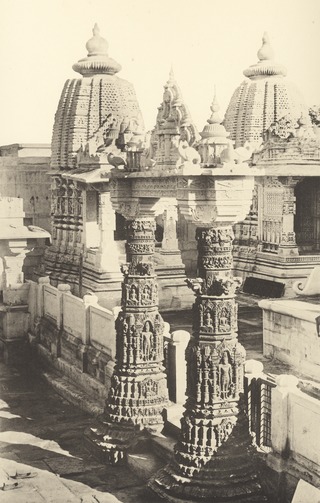
The Mahavira Jain temple is built in Osian of Jodhpur District, Rajasthan. The temple is an important pilgrimage of the Oswal Jain community. This temple is the oldest surviving Jain temple in Western India and was built during the reign of Mahārāja Śrī Vatsarāja of Imperial Pratihāras. The temple is visited by both Jain and Hindu.
The Aluara Bronzes or Aluara Hoard represent a rare and important set of Jain images found in Aluara near Dhanbad region of Bihar, in Eastern India.
In 1956, 240 Jain bronze idols were discovered dating back to early medieval to medieval period. The Vasantgarh hoard, thus named after the place of discovery, Vasantgarh is located in the Sirohi District of Rajasthan, India.
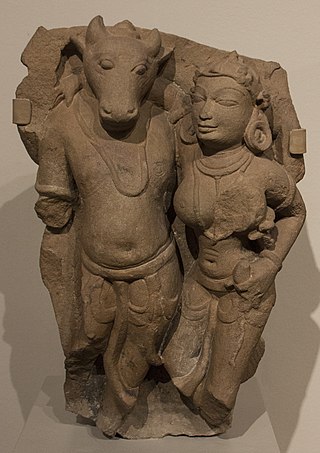
In Jain cosmology, Gomukha is the guardian god or Yaksha of Rishabhanatha, the first Tirthankara.
Panchasara Parshwanath temple is a Jain temple located in Patan, Gujarat. The temple was constructed in 8th century during the reign of Vanaraja Chavda of Chavda dynasty.

The Kumbharia Jain temples is a group of five Jain temples in the Kumbhariya, Banaskantha district in Gujarat, India. Constructed from 1062 to 1231 CE during the reign of the Chaulukya dynasty, they are noted for their elaborate architecture.
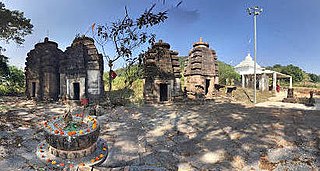
Subai Jain temples is a group of Jain temple in Subai village of Koraput district, Odisha.

Pakbirra Jain temples is a group of three Jain temples in Pakbirra village in Purulia district of West Bengal.

















